#ULiège
Text

(E.)LASKER–SCHÜLER.Sämtliche Gedichte;mit einem nachwort von (U.)WOLF.FISCHER Klassik.2016(2021).Frankfurt am Main.432pp.(Gedichte 1903 bis 1905).p.78: "Vollmond.||Leise schwimmt der Mond durch mein Blüt…|Schlummernde Töne sind die Auge der Tage.|Wandelhin…taumelher…|Ich kann deine Lippen nicht finden.|Wo bist Du ferne Stadt|Mit den segnenden Düften…..|Immer senken sich meine Lider|Ueber die Welt| Alles schläft….|Und hinter dem Mittag beugt sich|Ein alter, traumweißer Wind|Und bläst die Sonne aus.||
#ULiège#Else Lasker–Schüler#poetry#expressionism#Kitchenev pogrom#1904#Russian Revolt#1905#Sibelius#YouTube#Magical_Tales_of_Wolves#Chang#die Brücke#Modigliani
2 notes
·
View notes
Text
ODE A LA RECHERCHE URBAINE ET TERRITORIALE EN HAINAUT
parce que la recherche c'est aussi fait pour penser l'avenir d'un territoire. #engagement #thinkglobalactlocal
Temps de lecture : 5 minutesmots-clés : Hainaut, Instituts de recherche, UMONS, ULB, ULiège, UCL, Condorcet, territorialité, plateforme de recherche
Chers lecteurs,
Il y a parfois des moments, des croisements qui font réfléchir. Aujourd’hui, je lisais un article du Monde, Ce que la recherche apprend aux villes (Laetitia Van Eechkout, 10 octobre 2023). Étonnamment, cet article est classifié…

View On WordPress
#cities#Condorcet#Hainaut#Instituts de recherche#plateforme de recherche#territorialité#UCL#ULB#ULiège#UMons#urbanplanning
0 notes
Text

Astronomers discover WASP-193b, a giant planet with a density similar to that of cotton candy
An international team led by researchers from the EXOTIC Laboratory of the University of Liège, in collaboration with MIT and the Astrophysics Institute in Andalusia, has just discovered WASP-193b, an extraordinarily low-density giant planet orbiting a distant sun-like star.
This new planet, located 1,200 light-years from Earth, is 50% larger than Jupiter but seven times less massive, giving it an extremely low density comparable to that of cotton candy.
"WASP-193b is the second least dense planet discovered to date, after Kepler-51d, which is much smaller," explains Khalid Barkaoui, a Postdoctoral Researcher at ULiège's EXOTIC Laboratory and first author of the article published in Nature Astronomy.
"Its extremely low density makes it a real anomaly among the more than five thousand exoplanets discovered to date. This extremely low density cannot be reproduced by standard models of irradiated gas giants, even under the unrealistic assumption of a coreless structure."
The new planet was initially spotted by the Wide Angle Search for Planets (WASP), an international collaboration of academic institutions that together operated two robotic observatories, one in the northern hemisphere and the other in the south. Each observatory used an array of wide-angle cameras to measure the brightness of thousands of individual stars across the entire sky.
In data taken between 2006 and 2008, and again from 2011 to 2012, the WASP-South observatory detected periodic transits, or dips in light, from the star WASP-193. Astronomers determined that the star's periodic dips in brightness were consistent with a planet passing in front of the star every 6.25 days. The scientists measured the amount of light the planet blocked with each transit, which gave them an estimate of the planet's size.
The team used then the TRAPPIST-South and SPECULOOS-South observatories—directed by Michaël Gillon, FNRS Research Director and astrophysicist at ULiège—located in the Atacama Desert in Chile to measure the planetary signal in different wavelengths and to validate the planetary nature of the eclipsing object.
Finally, they also used spectroscopic observations collected by the HARPS and CORALIE spectrographs—also located in Chile (ESO)—to measure the mass of the planet.
To their great surprise, the accumulated measurements revealed an extremely low density for the planet. Its mass and its size, they calculated, were about 0.14 and 1.5 that of Jupiter, respectively. The resulting density came out to about 0.059 grams per cubic centimeter.
Jupiter's density, in contrast, is about 1.33 grams per cubic centimeter; and Earth is a more substantial 5.51 grams per cubic centimeter. One of the materials closest in density to the new, puffy planet, is cotton candy, which has a density of about 0.05 grams per cubic centimeter.
"The planet is so light that it's difficult to think of an analogous, solid-state material," says Julien de Wit, professor at Massachusetts Institute of Technology (MIT) and co-author. "The reason why it's close to cotton candy is because both are pretty much air. The planet is basically super fluffy."
The researchers suspect that the new planet is made mostly from hydrogen and helium, like most other gas giants in the galaxy. For WASP-193b, these gases likely form a hugely inflated atmosphere that extends tens of thousands of kilometers farther than Jupiter's own atmosphere. Exactly how a planet can inflate so much is a question that no existing theory of planetary formation can yet answer. It certainly requires a significant deposit of energy deep into the planet's interior, but the details of the mechanism are not yet understood.
"We don't know where to put this planet in all the formation theories we have right now, because it's an outlier of all of them. We cannot explain how this planet was formed. Looking more closely at its atmosphere will allow us to constrain an evolutionary path of this planet," adds Francisco Pozuelos, astronomer at the Instituto de Astrofisica de Andalucia (IAA-CSIC, Granada, Spain).
"WASP-193b is a cosmic mystery. Solving it will require some more observational and theoretical work, notably to measure its atmospheric properties with the JWST space telescope and to confront them to different theoretical mechanisms that possibly result in such an extreme inflation," concludes Barkaoui.
IMAGE....WASP-193 b as an exquisite target for atmospheric characterization. a, Synthetic transmission spectrum model and best-fit model for the injection-retrieval test for a single JWST/NIRSpec/Prism transit of WASP-193 b. Models and tests are produced with the TIERRA pipeline . b, Posterior probability distributions of the key planetary properties retrieved, showcasing that one single JWST visit can yield the constraints on the main atmospheric properties and the planetary mass within ~0.1 dex and ~1%, respectively. The red line represents the true value used in generating the synthetic spectrum. MR is the volume mixing ratio and P0 is the reference pressure corresponding to reference radius. Credit: Nature Astronomy (2024). DOI: 10.1038/s41550-024-02259-y
2 notes
·
View notes
Photo
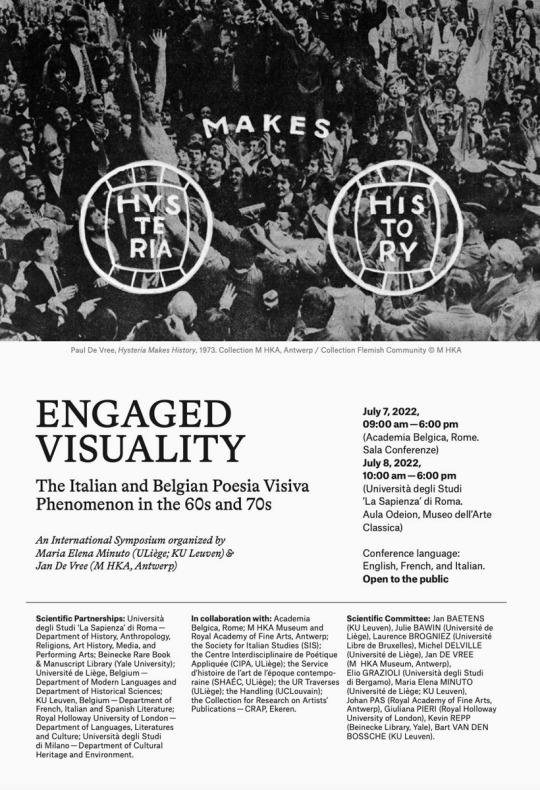


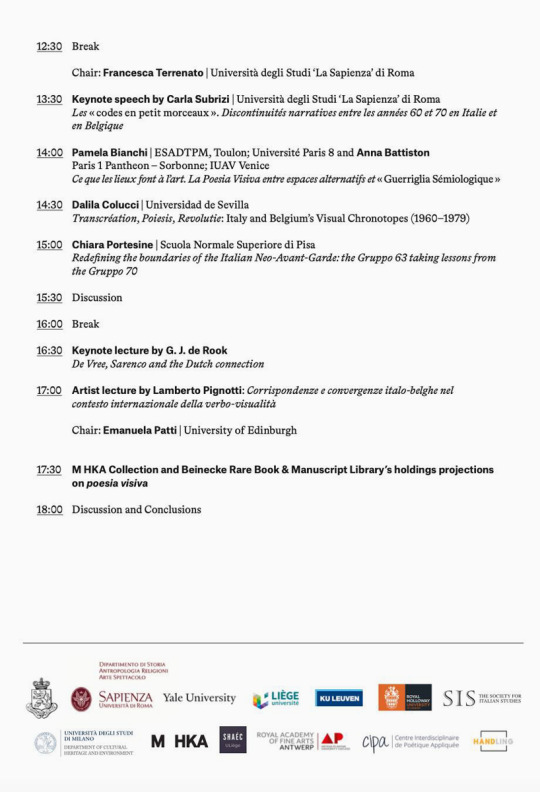
Engaged Visuality. The Italian and Belgian Poesia Visiva Phenomenon in the 60s and 70s, International Symposium, Organized by Maria Elena Minuto (Université de Liège; KU Leuven) and Jan De Vree (M HKA Museum, Antwerp), Academia Belgica, Roma, July 7, 2022 / Università degli Studi di Roma 'La Sapienza', July 8, 2022
Engaged Visuality. The Italian and Belgian Poesia Visiva Phenomenon in the 60s and 70s. An International Symposium organized fifty-one years after «Lotta Poetica» foundation.
Feat. Alain Arias-Misson, G. J. de Rook, Anna Oberto, Lamberto Pignotti.
Moderators: Florian Mussgnug (UCL London), Emanuela Patti (University of Edinburgh), Bartolomeo Pietromarchi (MAXXI, Roma), Franca Sinopoli (Università degli Studi di Roma 'La Sapienza'), Francesca Terrenato (Università degli Studi di Roma 'La Sapienza')
Scientific Partnerships: Università degli Studi “La Sapienza” di Roma – Department of History, Anthropology, Religions, Art History, Media, and Performing Arts; Beinecke Rare Book & Manuscript Library (Yale University); Université de Liège, Belgium – Department of Modern Languages and Department of Historical Sciences; KU Leuven, Belgium – Department of French, Italian and Spanish Literature; Royal Holloway University of London – Department of Languages, Literatures and Culture; Università degli Studi di Milano – Department of Cultural Heritage and Environment.
In collaboration with: Academia Belgica, Rome; M HKA Museum and Royal Academy of Fine Arts, Antwerp; the Society for Italian Studies (SIS); the Centre Interdisciplinaire de Poétique Appliquée (CIPA, ULiège); the Service d'histoire de l'art de l'époque contemporaine (SHAÉC, ULiège); the UR Traverses (ULiège); the Handling (UCLouvain); the Collection for Research on Artists’ Publications – CRAP, Ekeren.
Scientific Committee: Jan BAETENS (KU Leuven), Julie BAWIN (Université de Liège), Laurence BROGNIEZ (Université Libre de Bruxelles), Michel DELVILLE (Université de Liège), Jan DE VREE (M HKA Museum, Antwerp), Elio GRAZIOLI (Università degli Studi di Bergamo), Maria Elena MINUTO (Université de Liège; KU Leuven), Johan PAS (Royal Academy of Fine Arts, Antwerp), Giuliana PIERI (Royal Holloway University of London), Kevin REPP (Beinecke Library, Yale), Bart VAN DEN BOSSCHE.
#graphic design#art#poetry#concrete poetry#visual poetry#sound poetry#conference#symposium#magazine#maria elena minuto#jan de vree#lotta poetica#sarenco#paul de vree#academia belgica#alain arias misson#g. j. de rook#anna oberto#lamberto pignotti#2020s
22 notes
·
View notes
Photo
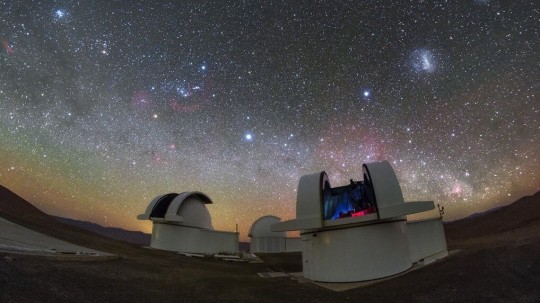
A new planet 100 light-years away could be suitable for life : NPR
An international team of scientists says it has discovered two new "super-Earth" type planets about 100 light-years away, one of which may be suitable for life.
Unlike any of the planets in our solar system, the nearly 1,600 known super-Earths are larger than Earth, but lighter than icy planets like Uranus and Neptune.
Researchers at Belgium's University of Liège announced Wednesday that they found another one while using Earth-based telescopes to confirm the existence of a different planet initially discovered by a NASA satellite in the same solar system.
NASA's satellite found planet LP 890-9b, which is about 30% larger than Earth and orbits its sun in just 2.7 days. ULiège researchers used their SPECULOOS (Search for habitable Planets EClipsing ULtra-cOOl Stars) telescopes in Chile and Spain to take a closer look at the planet with high-precision cameras.
That's when the stargazers discovered another planet, LP 890-9c (renamed SPECULOOS-2c by the ULiège researchers), which is 40% larger than Earth and takes 8.5 days to orbit its sun. ...
8 notes
·
View notes
Photo
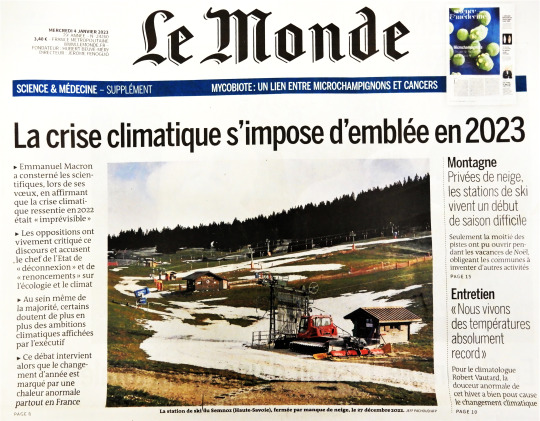
«Le discours de Macron rate le sens de l’histoire. Il aurait pu être tenu dans les années 1980, pas en 2022 »
Magali Reghezza-Zitt, géographe et membre du Haut Conseil pour le climat
Dire en 2022 qu'on ne savait pas, c'est simplement une 'fake news'.
Les modèles du climat sous-estimeraient-ils le réchauffement climatique induit par les activités humaines ?
Professeur Xavier Fettweis (Uliège)
3 notes
·
View notes
Text
L'Université de Liège découvre une exoplanète en orbite autour de l'étoile Speculoos-3: "Elle a pratiquement la même taille que la Terre" - L'Avenir
Source: lavenir.net
0 notes
Link
The Einstein telescope project has reached a new stage, with the E-TEST prototype—developed in the ULiège and CSL laboratories—being sent to the Liège Space Centre to undergo a battery of cryogenic and vibration tests. To function optimally, the future mirror of the Einstein telescope has to withstand being cooled to extreme temperatures and be subjected to almost no vibration.
0 notes
Text
FN Herstal and John Cockerill Spearhead AI Defense Research with ULiège Partnership
FN Herstal and John Cockerill have joined forces with the Walloon Region to finance a dedicated chair at ULiège focusing on artificial intelligence (AI) and defense. This innovative four-year collaboration, backed by a substantial investment of 160,000 euros per partner, aims to position both companies at the forefront of AI technology in the defense industry. The strategic significance of this project has been highlighted by Minister of the Economy Willy Borsus (MR), emphasizing the critical role that technological advancements, particularly in digitalization and AI, will play in the future of the sector. With a workforce of 12,000 people in Wallonia dependent on the defense industry, the collaboration between ULiège, FN Herstal, and John Cockerill aims to bolster industrial sovereignty in the face of evolving global security dynamics.
FN Herstal and John Cockerill have joined forces with the Walloon Region to finance a dedicated chair at ULiège focusing on artificial intelligence (AI) and defense. This innovative four-year collaboration, backed by a substantial investment of 160,000 euros per partner, aims to position both companies at the forefront of AI technology in the defense industry. The strategic significance of this…

View On WordPress
0 notes
Text
« Le problème des punaises de lit est le même en Belgique qu’en France »
Depuis quelques années, la Belgique se trouve, elle aussi, face à des infestations de cet insecte qui se nourrit de sang, provoque des démangeaisons mais ne transmet heureusement pas de maladies.
”Le problème des punaises de lit est le même en Belgique qu’en France, mais on le cache mieux chez nous”
Sophie Devillers
Publié le 02-10-2023
Mis à jour le 05-10-2023
Punaises de lit, la psychose qui envahit le monde
En France, la présence de punaises de lit a été signalée ces dernières semaines dans des cinémas, TGV ou dans le métro parisien. Une situation qui suscite une forte émotion. Face à l’appel de la mairie de Paris pour agir contre ce “fléau”, le gouvernement a annoncé une réunion de crise.
De la taille d’un pépin de pomme, ces insectes causent des piqûres en se nourrissant la nuit de sang humain, se dissimulant le plus souvent dans les matelas ou sommiers. ” Les punaises de lit sont typiquement ce qu’on appelle des insectes autostoppeurs, mais qui ici se font emmener contre le gré de celui qui les transporte. Cet insecte se loge dans les valises, les vêtements, les chaussures, tous les effets personnels, détaille l’entomologiste François Verheggen (ULiège), qui a participé au tout récent rapport scientifique de l’Anses, l’équivalent de l’Afsca en France, sur la lutte contre les punaises de lit. Les infestations prennent beaucoup d’ampleur en France pour différentes raisons notamment liées à un tourisme important, à un grand secteur hôtelier, aux déplacements de personnes… Les logements sociaux peuvent aussi être rapidement touchés vu l’important turnover. En outre, les punaises de lit peuvent aussi se déplacer, et ont donc la capacité de passer d’un appartement à un autre. Un autre facteur est la difficulté de diagnostic : les médecins généralistes ne sont pas formés et même le dermatologue va avoir bien du mal à faire la différence entre des piqûres de moustique ou des piqûres de punaises de lit.”
En outre, poursuit le scientifique, d’un point de vue social, cette problématique reste très difficile à assumer car les punaises de lit sont encore trop souvent considérées comme étant le symptôme d’une mauvaise hygiène, de bas revenus ou d’un faible niveau social. “Ce qui n’est pas le cas du tout, toutes les études le montrent. Il ne faut pas confondre les punaises de lit avec les cafards, par exemple, qui vont bénéficier de nourriture oubliée dans un coin. La punaise de lit est en fait un insecte qui a besoin de repas sanguins réguliers afin de pouvoir passer une étape dans son cycle de développement, de l’œuf à l’adulte. Les punaises de lit ne transportent pas de maladies mais, comme pour une piqûre de moustique, de guêpe ou d’abeilles, il existe des personnes allergiques ou qui vont faire des réponses plus importantes. Et cela ne se limite pas à une démangeaison. Comme le disait le psychologue de notre équipe, les infestations de punaises de lit sont un viol de notre intimité, comparables à un cambrioleur qui rentrerait chez vous. Votre lit, votre chambre à coucher, ce sont vraiment les endroits de votre intimité, c’est là où vous reposez en toute confiance. À ce niveau, c’est donc très différent d’une piqûre de guêpe ou d’abeille.”
Aussi présentes en Belgique
En Belgique, “depuis quelques années, on assiste à des infestations de punaises, après qu’elles ont été ramenées de voyage. Pour ce qui est de l’explosion des infestations évoquée chez nos voisins, la hausse est également présente mais elle n’est pas aussi importante que dans certaines régions françaises comme à Paris ou en Amérique du Nord il y a quelques années”, complète le professeur d’entomologie Frédéric Francis (ULiège), qui précise cependant qu’il n’existe pas d’institution en Belgique qui comptabilise les cas ou les plaintes quant aux punaises de lit, contrairement à ce qui se fait dans l’Hexagone, où l’on dispose de chiffres précis (entre 2017 et 2022, 11 % des ménages français auraient été infestés, selon un songe Ipsos pour l’Anses). “Il n’y a pas de suivi ou de surveillance continue et financée. Il faut dire qu’indépendamment des désagréments que cela peut causer et du fait que des personnes peuvent être sensibles et éprouver des démangeaisons cutanées très importantes, ces punaises ne sont pas vecteurs de maladie, au contraire des moustiques ou d’autres insectes hématophages. Le suivi est donc évidemment moins direct. Mais c’est une problématique négative pour laquelle il faut être vigilant.”
De son côté, la chercheuse-entrepreneuse Anne-Catherine Mailleux, entomologiste et fondatrice de l’entreprise Domobios qui commercialise des pièges anti-punaises de lit à destination des sociétés fournissant les désinsectiseurs ou les grandes surfaces, confirme l’absence de chiffres précis pour la Belgique, mais ne voit cependant pas la raison pour laquelle notre pays serait protégé. “Je pense que le problème est le même en Belgique qu’en France. D’ailleurs, depuis 2018-2019, tant les désinsectiseurs français que les désinsectiseurs belges voient leurs demandes d’intervention pour les punaises de lits doubler chaque année. C’est ce qu’ils me disent. Certaines entreprises ne font plus que cela ! Déjà en 2014-15, lorsque je m’étais intéressée à la question, j’avais constaté que les plaintes augmentaient d’année en année dans les hôtels bruxellois. C’est un problème en Belgique, mais c’est un problème relativement caché chez nous. On le cache mieux qu’en France. On en parle moins et les hôtels prennent le problème très au sérieux : dès qu’ils apprennent la présence de punaises de lit, ils réagissent très vite, même chose pour les Bed and breakfast. La présence de punaises de lit concerne particulièrement les grandes villes : Anvers et Bruxelles sont les deux points chauds car c’est là aussi qu’on voyage le plus.”
Sur LN 24, Raphaël Godfrin, codirecteur de la société Antinuisible, indiquait de son côté qu’il observe une augmentation de 300 % des infestations par des punaises depuis deux ans en Belgique. “Le phénomène est de plus en plus fort depuis quatre ou cinq ans et est encore remonté en flèche cette année.”
Elles se cachent très bien
Malheureusement, se débarrasser de punaises de lit est très compliqué, avertit Anne-Catherine Mailleux : “Les punaises de lit ont toujours vécu avec nous, mais étant donné que nos maisons sont devenues plus confortables (chaudes et un peu humides), elles se sont multipliées. Au début, on pensait qu’on allait pouvoir les éradiquer avec l’insecticide DDT, interdit à présent. Cela a effectivement pas mal marché au début, mais désormais on se retrouve face à des populations qui ont développé une résistance au DDT. Régulièrement, on découvre de nouveaux insecticides, mais au bout de quelques années, les punaises deviennent aussi résistantes. On se retrouve donc sans armes.”
Une autre difficulté tient au fait que les punaises “sont capables de se cacher un peu partout, elles aiment beaucoup ce qui est fissures et endroits très étroits” : dans les fissures dans le mur, dans les bouchons qui supportent les lattes en bois d’un sommier, le long des coutures d’une housse de couette, ou même dans les boules décoratives bloquant la tringle d’un rideau… Or, ces endroits sont difficiles à atteindre en cas de pose de produit insecticide, qu’il faut réappliquer plusieurs fois pour cibler tous les animaux. “Et si une punaise de lit sent l’insecticide, elle peut même se réfugier dans une gaine électrique… Comment poser de l’insecticide à un tel endroit ?”
Concrètement, que faire si on se retrouve face à ces petits insectes au corps plat et arrondi chez nous ? Première étape, conseille Mme Mailleux : sortir de la pièce infectée tout le linge de lit, les vêtements, lampes, livres… Les mettre dans des sacs hermétiques dans une autre pièce puis laver à 60°C avec du savon. Ou… les congeler, afin de tuer les punaises de lit et surtout leurs œufs qui pourraient s’y être réfugiés. “C’est un énorme travail, cela demande beaucoup d’énergie. Aux États-Unis, les pompiers ont vu leur nombre d’interventions augmenter à cause des punaises de lit, car certaines personnes touchées, excédées, préféraient tout brûler…”
Ensuite, pour la désinfection de la pièce elle-même, la meilleure solution, selon l’entomologiste est d’appeler un professionnel. “Les désinsectiseurs professionnels utilisent des produits de plus en plus intelligents, ils changent de produits à chaque fois, diminuent les doses mais essayent de les appliquer le plus localement possible. Les insecticides qui sont en vente pour les particuliers en grande surface ne sont pas très concentrés, contrairement aux insecticides des professionnels. Vous allez tuer quelques individus et les autres se cacheront et seront beaucoup plus compliqués à trouver. Cela ne fait que renforcer le problème.”
Alternative sans insecticide
Une alternative sans insecticide est possible : l’élimination par le froid (neige carbonique) ou par le chaud, avec de la vapeur sèche et des appareils diffusant de la vapeur d’eau extrêmement chaude et contenant très peu d’eau. L’appareil est passé très lentement sur les fissures, afin de tuer les adultes aussi bien que les œufs. Ces appareils peuvent être loués aux particuliers, mais vu les risques à ces températures élevées, l’utilisateur doit se montrer extrêmement prudent, avertit Anne-Catherine Mailleux. Autant le savoir : une désinsectisation par un professionnel coûte plusieurs centaines d’euros.
Quant aux pièges à punaises conçus par Domobios, ils consistent en de petits abris en carton attirants pour les punaises et dotés d’un plafond recouvert de colle. Lorsque la punaise s’y retrouve complètement collée, elle a déjà appelé ses congénères à la rejoindre dans cet abri agréable. Ces pièges, qui peuvent être posés dans les lits, n’ont pas pour but de capturer toutes les punaises de lit d’un domicile, mais permettent de les détecter le plus tôt possible et/ou de confirmer leur présence avant l’intervention d’un professionnel et enfin de déterminer qu’elles ont bien disparu après une désinsectisation."
-------
NDÉ
Le rapport de l'ANSES
Les punaises de lit : impacts, prévention et lutte - Avis de l’Anses - Rapport d’expertise collective Juillet 2023 https://www.anses.fr/fr/system/files/BIOCIDES2021SA0147Ra.pdf
Le site de Domobios
→ Détecter et éliminer les insectes de votre hôtel ou votre restaurant https://www.domobios.com/detecter-eliminer-insectes-hotel-restaurant/#Piege_lineaire_BedBugs
Bernadette Cassel's insight:
https://www.scoop.it/search?q=Domobios
(Re)lire aussi
Profession : exterminateur de punaises de lit, une journée avec Abdoulaye Diatta - De www.nouvelobs.com - 4 novembre, 18:45
« En continuant à utiliser des insecticides, on sélectionne les punaises de lit résistantes » - De theconversation.com - 14 octobre, 19:51
0 notes
Text
Entrepreneurs brains: Researchers reveal increased cognitive flexibility
Using resting-state functional magnetic resonance imaging (rs-fMRI), the study showed that serial entrepreneurs have higher connectivity between the right insula (associated with cognitive flexibility) and the anterior prefrontal cortex (a key region for exploratory choices), compared to their fellow managers. These results, published in the journal Entrepreneurship Theory and Practice, suggest that serial entrepreneurs possess greater cognitive flexibility, enabling them to alternate effectively between exploration and exploitation, a balance that is crucial to their success.
Unlike the traditional fMRI approach based on tasks submitted to the subject, the rs-fMRI on which this study is based observes the brain at rest, in the absence of cognitive tasks or presentation of stimuli, which constitutes an innovative approach to improving understanding of the entrepreneurial mind. Forty people, entrepreneurs and managers, took part in the study.
“This study represents an important advance in our understanding of the entrepreneurial mind. It highlights the potential of neuroscience and how this approach complements the traditional tools used to study entrepreneurial cognition. By highlighting the difference in cognitive flexibility, it also offers a new perspective to inform the design of training or professional development programmes aimed at improving the cognitive flexibility and entrepreneurial spirit of individuals within various organisations,” explains Frédéric Ooms, researcher and Assistant Professor in management and entrepreneurship (HEC — ULiège School of Management), first author of the publication, based on the results of his PhD thesis on entrepreneurial cognitive flexibility presented in April 2023.
“In a world of rapid and unpredictable change, organisations need to cultivate an entrepreneurial mindset and foster cognitive flexibility within their teams, qualities recognised by the OECD as a 21st century challenge,” points out Professor Bernard Surlemont, Professor of Entrepreneurship at ULiège (HEC Liège).
“This collaborative, multidisciplinary study illustrates ‘neuro-entrepreneurship’, the integration of knowledge in neuroscience (at the ULiège GIGA and the CHU of Liège) and the world of entrepreneurship (HEC Liège), and shows how neuroimaging techniques help to better visualise the neural networks involved in ‘cognitive flexibility’, in order to be able to adapt to a constantly changing reality, which is the source of entrepreneurial success,” notes Dr Steven Laureys, neurologist and Clinical Professor at the Centre du Cerveau of the University Hospital (CHU) of Liège, Research Director at the Fund for Scientific Research — FNRS and Visiting Professor at the CERVO Research Centre (Laval, Quebec).
0 notes
Text
(P)ARDENNE.UN ART CONTEXTUEL; Création artistique en milieu urbain, en situation, d'intervention, de participation. éd.FLAMMARION. coll. Champs,arts.2002.pp255. :"La position de l'art 'contextuel' en résumé : mettre à bonne distance représentations (l'art classique), détournements (l'art d'esprit duchampien), perspective autocritique où l'art se considère et se dissèque lui-même, de façon tautologique (l'art conceptuel). | Son pari : faire valoir le potentiel critique et esthétique de pratiques artistiques plus portées à la présentation qu'à la représentation, pratiques proposées sur le mode de l'intervention, ici et maintenant. Là où le réalisme historique, au XIX[ième] siècle, n'avait pu s'arracher à l'habitude de la représentation, l'art 'contextuel' qui le prolonge entend pour sa part s'incarner. À travers lui se voient posées maintes questions, toutes relatives aux contingences de la vie présente : qu'est, au juste, la 'réalité', cette somme de circonstances ? L'artiste peut-il être en phase avec elle ? Une esthétisation viable de la politique, de l'économie, de l'écologie, des médias... est-elle possible ? Autant d'interrogations qui nous tourmenteront encore longtemps, sans nul doute, mais auxquelles ce[(s)] type de création[(s)] apporte des réponses différentes de l'approche artistique[(s)] classique. " (p 13)
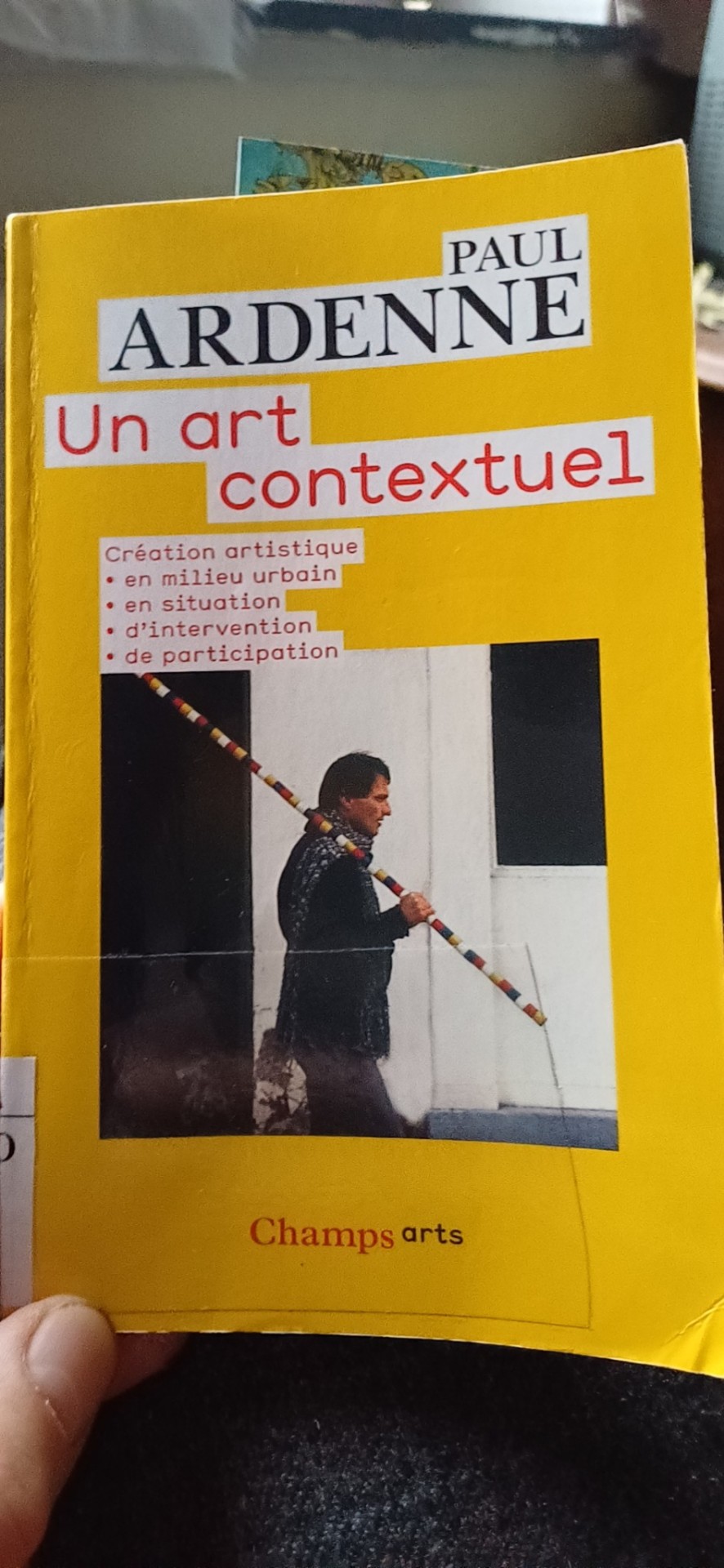
#marcel DUCHAMPS#Sol LeWitt#Turner#conceptual art#action statements#réalisme historique#COURBET#paul ARDENNE#flammarion#ULiège#professeur Dr(a) BAWIN#HAAR 0008-1#l'art à l'époque contemporaine#contemporary art#DAEFLE#Cambridge english#LTTB#international house#Wiener Kreis#Казимир МАЛЕВИЧЬ#Олга РОЗАНОВА#Suprematism#Cubism#Futurism#Fernand LÉGER
2 notes
·
View notes
Text
When innate lymphoid cells educate alveolar macrophages
Immunostaining AM ILC2. Credit: P.Loos and A.Hego-ULiège
A study conducted by researchers at the University of Liège on group 2 innate lymphoid cells (or ILC2s) shows that the functional reprogramming of these cells following their exposure to viruses allows our body to react differently to exposure to certain respiratory allergens. This study is published in Science Immunology.
The hygiene…
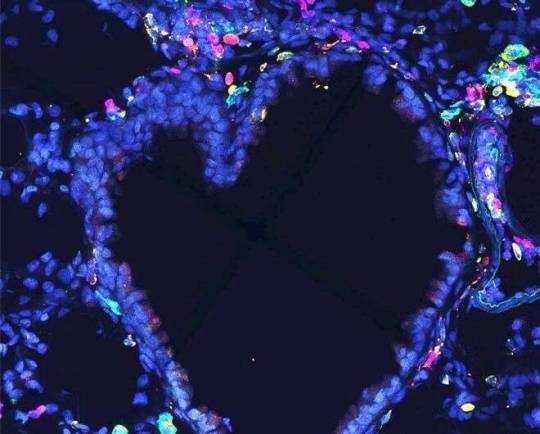
View On WordPress
0 notes
Photo

Astronomers from the University of Liège and CSIC discover a key planetary system to understand the formation mechanism of the mysterious 'super-Earths' A study led by researchers of the University of Liège and the CSIC - using observations from NASA's TESS telescope – presents the detection of a system of two planets slightly larger than Earth orbiting a cold star in a synchronized dance. Named TOI-2096, the system is located 150 light-years from Earth. The discovery is the result of a close collaboration between European and American universities and was made possible by the US space mission TESS (Transiting Exoplanet Survey Satellite), which aims to find planets orbiting nearby bright stars. "TESS is conducting an all-sky survey using the transit method, that is, monitoring the stellar brightness of thousands of stars in the search for a slight dimming, which could be caused by a planet passing between the star and the observer. However, despite its power to detect new worlds, the TESS mission needs support from ground-based telescopes to confirm the planetary nature of the detected signals," explains Francisco J. Pozuelos, astrophysicist, first author of the paper, former member of the ExoTIC laboratory at the Univeristy of Liège, and who has now joined the Spanish National Research Council (IAA-CSIC). The planets TOI-2096 b and TOI-2096 c were observed with an international network of ground-based telescopes, allowing their confirmation and characterization. The majority of the transits were obtained with telescopes of the TRAPPIST and SPECULOOS projects led by the University of Liège. “Making an exhaustive analysis of the data, we found that the two planets were in resonant orbits: for each orbit of the outer planet, the inner planet orbits the star twice," says Mathilde Timmermans, a doctoral student at the ExoTIC lab at ULiège and second author of the scientific paper. Their periods are therefore very close to being a multiple of each other with about 3.12 days for planet b and about 6.38 days for planet c. This is a very particular configuration, and it causes a strong gravitational interaction between the planets. This interaction delays or accelerates the passage of the planets in front of their star and could lead to the measurement of the planetary masses using larger telescopes in the near future.” The researchers behind the discovery estimate that the radius of planet b - the closest to its star - is 1.2 times that of Earth, hence the name 'super-Earth'. Its properties could be similar to Earth’s: a planet with a mostly rocky composition, possibly surrounded by a thin atmosphere. Similarly, the radius of planet c is 1.9 times the radius of the Earth and 55% that of Neptune, which could place the planet in the category of 'mini-Neptunes', planets composed of a rocky and icy core surrounded by extended hydrogen- or water-rich atmospheres, such as Uranus and Neptune in our Solar System. These sizes are very interesting because the number of planets with a radius between 1.5 and 2.5 Earth radii is smaller than what theoretical models predict, making these planets a rarity. These planets are of crucial importance given their sizes," notes Mathilde Timmermans, "the formation of super-Earths and mini-Neptunes remains a mystery today. There are several formation models trying to explain it, but none fits the observations perfectly. TOI-2096 is the only system found to date that has a super-Earth and a mini-Neptune precisely at the sizes where the models contradict each other. In other words, TOI-2096 may be the system we've been looking for to understand how these planetary systems have formed.” “Furthermore, these planets are among the best in their category to study their possible atmospheres," explains Francisco J. Pozuelos. Thanks to the relative sizes of the planets with respect to the host star, as well as the brightness of the star, we find that this system is one of the best candidates for a detailed study of their atmosphere with the JWST space telescope. We hope to be able to do this quickly by coordinating with other universities and research centers. These studies will help confirm the presence of an atmosphere, extensive or not, around planets b and c and thus give us clues as to their formation mechanism.” IMAGE....Artist's view of the TOI-2096 system CREDIT ©Lionel J. Garcia / ULiège
12 notes
·
View notes
Text
Tutoriel qgis 2.18 pdf français
TUTORIEL QGIS 2.18 PDF FRANÇAIS >> Telecharger
vk.cc/c7jKeU
TUTORIEL QGIS 2.18 PDF FRANÇAIS >> Lire en ligne
bit.do/fSmfG
tutoriel qgis 3.4 pdf français
introduction qgis pdfcours qgis 3.16 pdf
qgis pour les nuls
tutoriel qfield pdf
tutoriel cartographie qgis
cours complet qgis pdf
exercices corrigés qgis pdf
PDF tutoriel qgis 2.18 pdf. [PDF] Manuel de formation SIG sous QGIS 381 à - ORBi - ULiège [PDF] Tutoriel QGIS - Cours en Ligne - AgroParisTech. Nouveautés dans QGIS 2.18 · Premiers Pas · Installation · Launching QGIS · Sample Session: Load raster and vector layers · Projects · Output.
https://www.tumblr.com/nadacepowi/697175146787717120/leve-plaque-dexter-notice, https://www.tumblr.com/nadacepowi/697174879803506688/emploi-coiffeur-new-york, https://www.tumblr.com/nadacepowi/697175536323182592/foradil-mode-demploi-thermomix, https://www.tumblr.com/nadacepowi/697175025429659648/festina-f16489-mode-d-emploi, https://www.tumblr.com/nadacepowi/697175146787717120/leve-plaque-dexter-notice.
0 notes
Text
63 #sports à découvrir à l’occasion du Salon des Sports de l’Université de Liège
63 #sports à découvrir à l’occasion du Salon des Sports de l’Université de Liège
63 #sports à découvrir à l’occasion du Salon des Sports de l’Université de Liège
Découvrez et testez gratuitement les disciplines sportives ULiège Sports (anciennement RCAE) lors du salon des Sports et des Journées Portes ouvertes !
Natation, rugby, gymnastique, course d’orientation, zumba, aviron, pole dance… Pas facile de faire un choix parmi les 63 activités sportives proposées par ULiège…

View On WordPress
0 notes